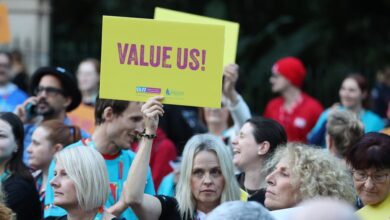Socially distanced nursing: the future of teaching?

While the COVID-19 pandemic has driven millions of people inside, many jobs in healthcare have not had that luxury.
And as health professionals kept calm and carried on, so too did nursing schools across the nation as graduating the current crop of nursing students became a priority.
Universities had to move quickly to change with the new realities of social distancing, and Deakin University’s School of Nursing and Midwifery redesigned its curriculum to essentially become a socially distanced nursing degree.
“It was really about how we can continue building that workforce into the future and making sure that the next wave of nurses and midwives are ready to take on that mantle,” says Dr Jo McDonall, senior lecturer and director of undergraduate studies.
The nursing school has taken many units online but crucially has devised socially distanced nursing and midwifery simulations in order to continue preparing the students for placements.
A monumental effort
After receiving special dispensation from the university hierarchy to continue face-to-face learning, McDonall and her team had to design the course to fit government requirements.
Usually classes run on a roughly one to 16 ratio, one facilitator to about 16 students in the room but, with what was at first a two square metre social distancing rule that later turned into four square metres, numbers reduced for these workshops.
“It was a monumental effort, to be honest, to actually get this up and going,” McDonall says.
“We really had to obviously measure our spaces and make sure that the numbers of students were going to meet the government requirements within that social distancing. We had to also make sure that our staff were prepared on how to facilitate that.
“We developed videos and things to help staff prepare to facilitate a class using social distancing and we also had to prepare the students. So it was about what they were going to expect to come and what social distancing rules were in place, making sure that we had the appropriate signage. There's a whole lot of work that went on behind the scenes to make sure that our spaces were prepared, but also our students and our staff were prepared for this new way of teaching.”
Students adapt to change
The change has been tough for students, but as future nurses who will face daily challenges, most have adapted well and welcomed the certainty that their studies would continue.
“Obviously going from that face to face to an online method, especially when nursing is such a hands on degree, there was a bit of uncertainty and also just [working out] what that was going to look like in terms of our clinical placements," says second year student Brianna Bucca.
"But it was all just a bit of, ‘I'm not too sure what this is going to look like’ and just going with the flow.”
Fourth year student Jessica Williams had the added worry that the pandemic might disrupt her graduation.
“Similar to Brianna, I was quite anxious at the start because it was more the fear of the unknown. You didn't quite know if our placements were going to be cancelled or how to actually practise our practical skills and things like that,” says Williams.
“But I think it helped that we already did have some online tutorials and things like that with Deakin having lots of videos. So then that made it a little bit easier to adjust to the whole online situation.
“I was a bit worried because, especially with the midwifery side of things, we have competencies that we have to achieve. So in that respect, it was a bit challenging because you didn't know whether you will be on placement, whether you will be taken off placement and then how we're going to reach the marks that we have to get for our course to be completed for our registration.”

Smaller classes, better outcomes?
Both Bucca and Williams say that the transition to independent online learning was challenging, but they credit the facilitators with guiding them through the process. The same goes for the face-to-face simulations, but the smaller class sizes proved to be an unexpected bonus.
“I thought that it was challenging at the start because you just have to constantly have it on your mind, not to get too close to people and things like that with the distancing. But then there was heaps of signs up with all the different measures. The uni went to extreme lengths to try and make sure that all the safety measures were in place and things like the markings on the floor and the hand hygiene was everywhere,” Williams says.
“And I actually almost preferred it because of the ratio of the facilitator to the student. There was that one or three facilitators and then four students. It was more efficient, and you got less distracted by other students and you were supported, and it was more condensed with your learning. So, if we'd come in one week, we would do three weeks’ worth of practical skills in that one week.”
McDonall agrees. She feels that smaller classes help the teachers to get a better sense of a student's learning, allowing them to be able to provide key feedback as they're going.
However, it does add to the overall workload of the department.
“It definitely was much more intensive for staff to facilitate just given our sheer numbers across our undergraduates – 3500 students across our three campuses – and just managing that logistically was a lot more taxing,” she says.
“And not only the facilitation staff, but also our sim staff, the support staff that are there to help restock the rooms and make sure that the equipment is available. We had to have more time to allow cleaning and cleaning down of equipment and things like that. So the scheduling of it was really important. We had stairs in this particular building, so we had staff around to make sure that the students were maintaining their social distancing and preparing themselves. So it was much more intensive from a teaching and learning point of view.”
However, McDonall says the positives outweigh any negatives. The lessons learned during this period will inform the new curriculum that Deakin has been devising for undergraduates, and other universities have approached the team to find out more about social distanced nursing.
And for Bucca and Williams, they feel the disruption caused by the pandemic has gone a way to prepare them for the hectic life of a nurse.
“We do quite a lot of inquiry-based learning. And I think this experience has really shown people how important that is as a skill to be able to teach yourself because when you get into the workforce, there's going to be things changing all the time or that you're going to have to teach yourself. I think for a lot of people, myself included, it's showing the importance of that skill," Bucca says.
"It's definitely showing that the world can change very quickly, especially in healthcare, and that we have got to be able to flex and change as the world changes."
“I completely agree with Brianna," Williams adds. "It is a challenging time and it is very fast paced. And when things were changing quite quickly, it meant that we had to be quite flexible with different things that we were doing, like coming in and putting the PPE on and things like that because it did change so regularly. It meant that we had to adapt with it, which I think is a great. I thought it was a good challenge and it'll help in the future."
Email: [email protected]





